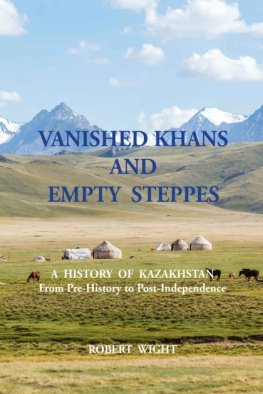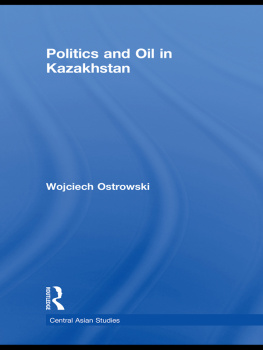ROBERT WIGHT
VANISHED KHANS
AND
EMPTY STEPPES
A HISTORY OF KAZAKHSTAN
From Pre-History to Post-Independence
London, 2014
Published in United Kindom
Hertforfshire Press Ltd 2014
9 Cherry Bank, Chapel Street
Hemel Hempstead, Herts.
HP2 5DE, UK
e-mail: publisher@hertfordshirepress.com
www.hertfordshirepress.com
VANISHED KHANS AND EMPTY STEPPES
A HISTORY OF KAZAKHSTAN
From Pre-History to Post-Independence
by Robert Wight
First edition
Proof editor Carole Mitchell
Typeset Aleksandra Vlasova & Allwel Solutions
All rights reserved. No part of this book may be reprinted or reproduced or utilised in any form or by any electronic, mechanical, or other means, now known or hereafter invented, including photocopying and recording, or in any information storage or retrieval system, without permission in writing from the publishers.
British Library Catalogue in Publication Data A catalogue record for this book is available from the British Library Library of Congress in Publication Data A catalogue record for this book has been requested
ISBN 978-0-9930444-0-3
For Jonathan and Nicholas
Contents
Appendices
CHAPTER ONE: PROLOGUE
When Major Mikhail Peremyshelsky, leading a detachment of imperial Russian troops and scouts, reached the northern foothills of the Tien Shan Mountains, and established a camp in a green and wooded valley at the foot of the Zailisky Alatau Ridge, his arrival was to mark a turning point in the history of Kazakhstan, and in the Russian colonisation of Central Asia. Throughout previous centuries, Russian territorial expansion had been towards Lithuania and Poland to the west, over the land oceans of prairie grassland and treeless steppe to the south, and across the infinite expanse of Siberian forest and tundra to the east. Now further progress in a south-easterly direction was emphatically blocked by the near-impenetrable chain of mountains ahead, a formidable barrier towering up from the empty plains. From now on, Russia was to concentrate on settlement and consolidation in this vast region, and incorporation of the new lands into its growing empire, until eventual independence for Kazakhstan nearly 140 years later.
The date was 8 August 1853, and in the fierce heat of that summer, after a monthlong trek on horseback across the arid deserts of eastern Kazakhstan, the weary Russian soldiers could at last rest and relax in the cool, fresh air, high above the stifling atmosphere of the dusty plains below. Tall firs, pines, and silver birch trees gave welcome shade for the camp, a great relief after constant exposure to the blazing sun, while icy streams and rivulets, fed by melting snow and ice from the mountains and glaciers above, provided an endless supply of the clearest, coldest water. For days during their journey, the soldiers had observed how the majestic, snow-covered mountain summits on the horizon ahead appeared to float in the sky like clouds, a hazy, ever-receding mirage; in another trick of the light in the crystal-clear mountain air, pristine snow fields and distant glaciers, glinting in the dazzling sunshine, now seemed almost near enough to touch.
The Russians soon began to make clearings in the forest where they could build wooden cabins and stables. Acrid wood smoke from camp fires drifted slowly in the still mountain air, since although the days were hot under the blazing sun, in the evenings the temperature fell sharply, and the nights under the cloudless black sky, lit with millions of bright stars, were already intensely cold. In a few weeks the first snows of winter would be falling. But it was not only the approaching winter that was a cause for concern. Defensive stockades were also necessary to protect the encampment against the threat of attack from hostile local tribes, since the site was in the territory of the Great Horde, one of the three Hordes (broad groups of local khanates, nomadic tribes, and family clans) which made up the indigenous population of Kazakhstan. The Great Horde occupied the eastern and southern parts of Kazakhstan, from the region around Lake Zaisan in the north to Lake Balkhash and the foothills of the Tien Shan Mountains in the south. Four years earlier, in 1849 the tsarist government had signed a treaty with the khans of the Great Horde, formally incorporating their territory into the Russian empire. In the previous century, the territories of the Little Horde in the west around the Caspian Sea, and the Middle Horde, in the centre and the north of Kazakhstan, had already been absorbed by Russia. But in this new country, far from Russia itself and despite the 1849 treaty, which was readily ignored by local tribesmen, there was still deep hostility and resentment at Russian encroachment on Kazakh lands.
As they settled into their new surroundings, the Russians contemplated their situation. Not far to the south, beyond the first mountain range, lay the deep warm-water lake of Issyk Kul, a remote and mysterious inland sea rumoured to be the site of an ancient civilisation destroyed in an earthquake many centuries before. The ruins of houses and palaces, formal gardens and elaborate squares, according to legend, now lay deep below the surface. These legends turned out to have a basis in reality one hundred years later when underwater excavations in the 1950s revealed the remnants of buildings and settlements including Christian monasteries and Islamic minarets and mausoleums. The high mountain passes between the lake and the plains to the north were still known, even after six hundred years, as the routes taken by invading Mongol armies in the thirteenth century. Beyond Issyk Kul the rudimentary Russian maps, which mostly consisted of blank and empty spaces, showed a vast, mountainous wilderness, stretching for enormous distances towards China and the Himalayas. This hostile terrain of high peaks and inaccessible valleys, and unimaginable cold and desolation, was the home of wild animals, ravens and eagles, wolves and tigers, and the elusive and near-mythical snow leopard, a prominent subject in the art and decoration among the nomadic tribes on the plains below. This was also a region of ferocious blizzards and snowstorms, and violent tremors and earthquakes which occasionally sent thousands of tons of boulders and devastating mud slides crashing down into the valleys below. But all was silent now, as the white peaks of the mountains stood out with brilliant clarity against the enamel blue of the sky, massive sentinels guarding the entrance to another world. In the other direction to the north, the plains and empty scrubland which the Russians had just crossed offered some means of life to the indigenous nomadic communities, but were uninviting to any form of permanent habitation or settlement. By contrast, between the mountains and the plains, the broad and verdant country of untouched forests, quiet valleys, and fertile pastures where the Russians now found themselves provided a source of food, water, and everything necessary for life, all of which enhanced the site of the encampment and the surrounding countryside as a viable place for a permanent settlement. Among the Russian troops was a contingent of locally-recruited Kazakh horsemen who confirmed the attractions of the region. Thus Major Peremyshelsky was able to report back to St Petersburg: Given its favourable position in the Semirechie (Seven Rivers) region, and with plentiful supplies of wood, and wide expanses of fertile arable land and crops far superior to those of neighbouring areas of Issyk and Talgar, we propose that (this area) should be a place for future settlement. In sending this message, Mikhail Peremyshelsky in effect became the founder of the modern city of Almaty.
The Semirechie region (Zhetisu in Kazakh) lies in south-eastern Kazakhstan between the Tien Shan Mountains (the Mountains of Heaven) and the shallow and semi-arid Lake Balkhash. The region has occupied a unique place in Kazakh history, as the centre of ancient empires and with gathering places for early tribes. Most of the land consists of dry, sandy plains and sparsely-populated desert. To the east lies the Dzungarski Alatau Ridge, a range of high mountains beyond which lie the western-most regions of China. In reality the Semirechie contains several hundred short, fast-flowing rivers descending from the Dzungarski Alatau Mountains, but six of the most prominent seven rivers which give the region its name the Naryn, Karatal, Aksu, Lepsi, Saribulak, and Shalikti manage, at least in the spring, to reach the shores of Lake Balkhash. The seventh river, and the longest and most significant, is the Ili, a majestic but deceptively fast-flowing current which flows in a westerly direction, south of the Dzungarski Alatau Ridge, from its source high in the mountains of western China. Carrying enormous volumes of melting snow and ice, it descends into Lake Kapchagai at the foot of the Tien Shan Mountains; from there it turns to the north-west and continues for a further three hundred kilometres across the steppe, before ending its journey in a broad, marshy area at the southern end of Lake Balkhash. In common with the other rivers of the region, in the blazing heat of summer the Ili loses vast amounts of its water to evaporation and absorption in the parched sands along its route, and as a result Lake Balkhash remains poorly supplied with fresh water. The river gives its name to the Ili Gap, a wide, sandy valley stretching for hundreds of miles between the Dzungarski Alatau Ridge and the Tien Shan Mountains. In earlier centuries this had been a major corridor for Mongol and other invaders from the east. To the north lies the Dzungarski Gate, another invasion route in the narrow gap between the eastern end of the Dzungarski Alatau Ridge in Kazakhstan and the Tarbagatai Mountains in western China. The whole of the Dzungarski region, a borderland between Kazakhstan and China, has been marked by unrest and conflict; historically invasions have always come from the east, and the region has remained remote and sparsely populated.
Next page






